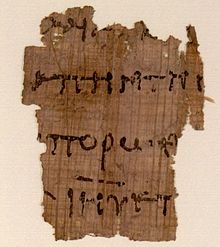Nomina sacra
In a few early cases, an alternate practice is seen of abbreviation by suspension, meaning that the initial two letters (at least) of the word are used; e.g., the opening verses of Revelation in 𝔓18 write Ἰησοῦς Χριστός (Jesus Christ) as ΙΗ ΧΡ.It is evident that the use of nomina sacra was an act of reverence rather than a purely practical space-saving device,[4]: 100, 104-106 as they were employed even where well-established abbreviations of far more frequent words such as and were avoided,[4]: 101 and the nomen sacrum itself was written with generous spacing.Biblical scholar Larry Hurtado has suggested Greek numerals as the origin of the overline spanning the nomen sacrum, with ΙΗ, the ordinary way of writing "18", being taken as reminiscent of a suspended form of ΙΗΣΟΥΣ (Jesus).[7] Linguist George Howard argues that κς (κύριος) and θς (θεός) were the initial nomina sacra, created by non-Jewish Christian scribes who "found no traditional reasons to preserve the tetragrammaton" in copies of the Septuagint.Hurtado, following Colin Roberts, rejects that claim in favour of the theory that the first was ιη (Ἰησοῦς), as suggested in the Epistle of Barnabas, followed by the analogous χρ (Χριστός), and later by κς and θς, at about the time when the contracted forms ις and χς were adopted for the first two.


ChristianoverlineBruce M. MetzgerCopticArmenianGothicOld NubianOld IrishCyrillic𝔓18Greek numeralstetragrammatonPapyrus Oxyrhynchus 1007Revelationthe Alpha and the OmegaGeorge HowardEpistle of BarnabasLycaoniaPapyrus 111P. Oxy.𝔓12𝔓13𝔓15𝔓16𝔓17𝔓20𝔓22𝔓24𝔓27𝔓28𝔓29𝔓30𝔓32𝔓35𝔓37𝔓38𝔓39𝔓40𝔓45P. Chester Beatty𝔓46𝔓47𝔓48𝔓49𝔓50𝔓53𝔓64𝔓65𝔓66P. Bodmer𝔓69𝔓70𝔓72𝔓75𝔓78𝔓90𝔓91𝔓92𝔓100𝔓101𝔓106𝔓108𝔓110𝔓111𝔓113𝔓114𝔓115𝔓121𝔓137ChristogramStaurogramComfort, Philip WesleyHurtado, Larry WeirLarry W. HurtadoRoberts, Colin HendersonWiktionaryTraube, Ludwig